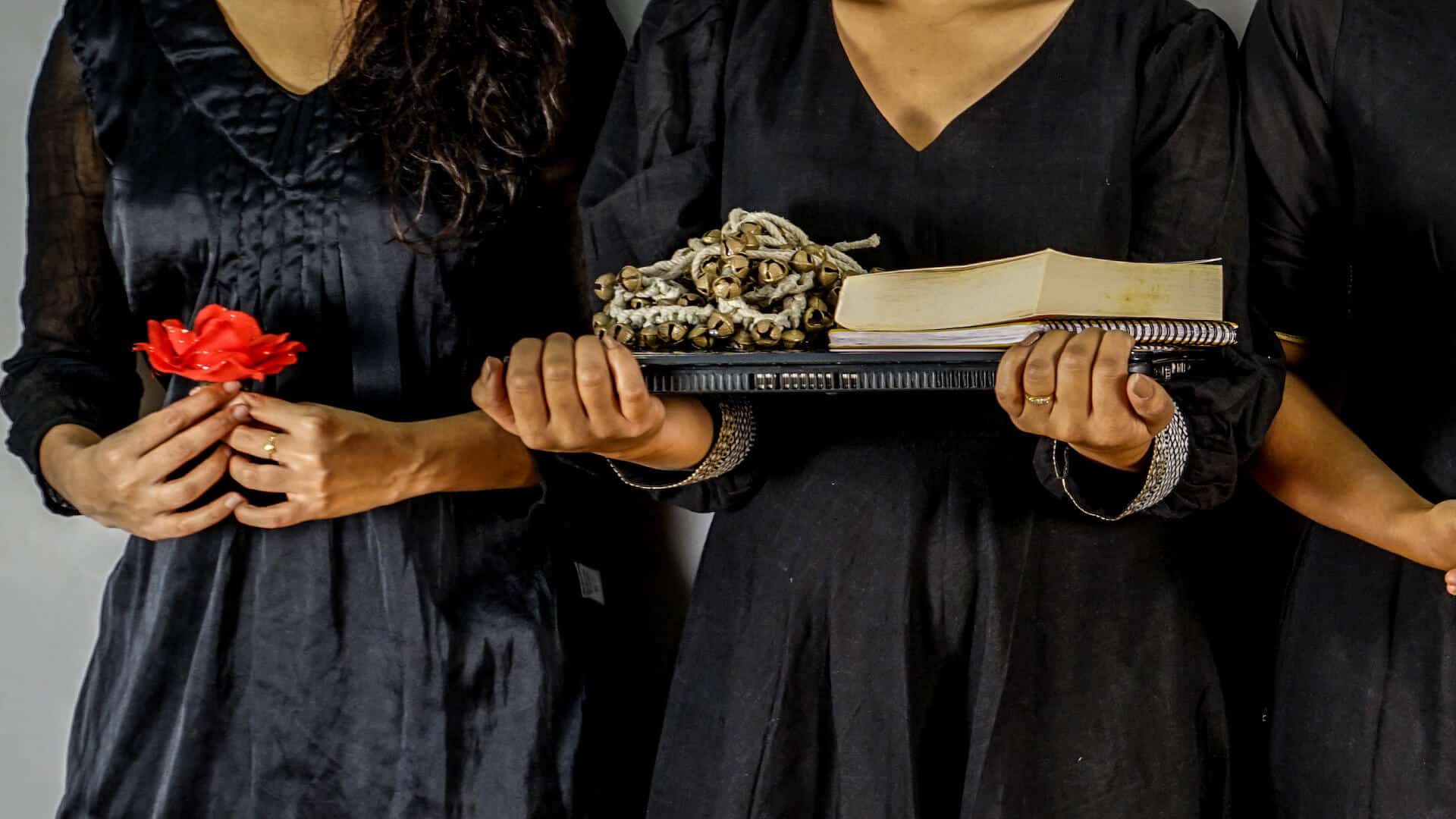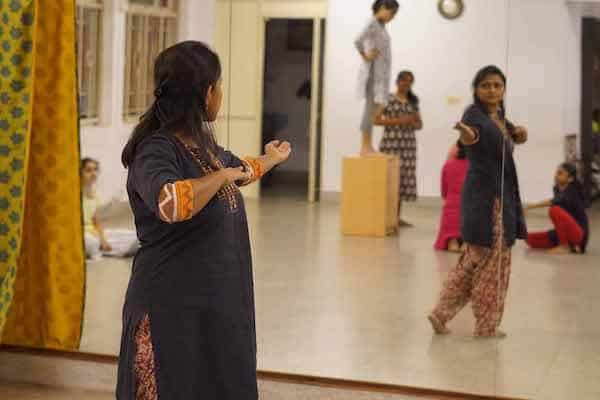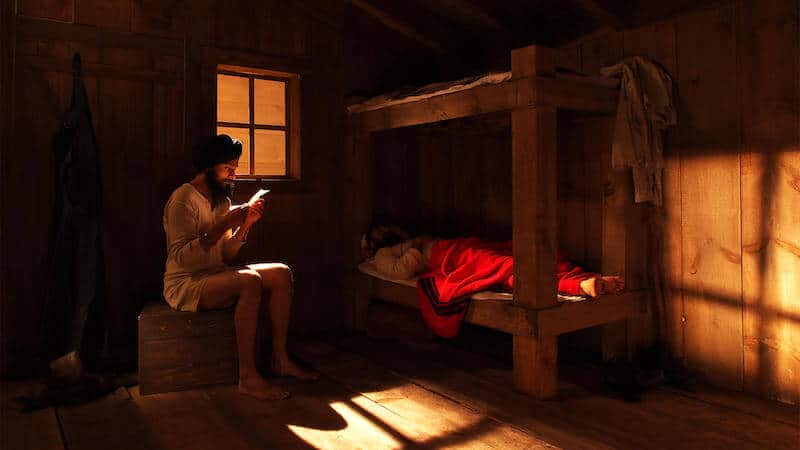No Movement Without a Beginning
Exploring political pasts/presents in kathak dance in Ottawa and Bangalore
Share Article
We started with questions. Many, many questions. Weeks before I was leaving Bangalore to move back to Ottawa, Mridula Rao, my friend and dance teacher of three years, sat down on the bed in the guest bedroom of her apartment where I was staying, having vacated my own apartment a few weeks before. And we began with our questions, and our desires. Now, six months into our journey, and continents apart, we have some answers, but mostly more questions. What follows here is a mid-creation artist’s reflection on context, process and trajectories.
Over the last century, Kathak has become a dance form that privileges a male narrative voice and fosters a ‘classical’ image of Indian identity (i.e. featuring upper caste bodies). If Mridula and I, as women, feel trapped by the former, we benefit from the latter as upper caste Hindus. And, even if we are conflicted about many of the narrative tropes Kathak employs, there is an undeniable agency and even pleasure to be found in playing with an audience’s gaze. Our task, as we see it, is to use what privilege we have, to subvert the patriarchal and increasingly Sanskritized nature of our form. Joined by dramaturg and documentary theatre artist Anuja Ghosalkar, we have set out to see if Kathak’s repertoire has room for the stories we want to tell, on our own terms: stories of the tawaifs and baijis who once practiced the form, now exoticized or erased from it; stories of our contemporary contexts, not divorced from the politics of our positions as an Indian and an Indo-Canadian, respectively; and stories from our personal pasts and presents.

We began by asking if there was space in Kathak's repertoire to articulate these new kinds of stories that went past the thumris, ghazals, taranas and vandanas that have been circulating for the past century or so. Is there room in Kathak's repertoire, in its movement vocabulary, its understanding of the body, and its approach to storytelling to express personal histories? Could it be used to point to the erasures in its own history, and the rise of the upper caste, middle class dancer as the tawaif was cast aside? Can we use Kathak to tell stories that acknowledged our privilege as upper caste women, as well as the limitations placed on us because of our gender and race, respectively? And, perhaps most importantly, could we reach out to audiences who we felt needed to hear this?

This is the biggest challenge we have set for ourselves, and likely is one that will have to wait to be answered until we begin working together in person again. We want to know if Kathak, as a form that lends itself to improvisation, can translate across cultures — beyond some notion of the ‘universality' of art. Kathak has a rich history of being adapted by solo or duet dancers for intimate performances for specific audiences and occasions. Over the past century this intimate performance style has been replaced with proscenium performances, choreographed for larger groups moving across stages that need to be seen from a distance. As Mridula and I started to articulate our questions with Anuja, we began to wonder if returning to more intimate kotha/salon-type settings could help us connect to diverse audiences with different kinds of stories.

We parted ways in August 2018 with our individual plans for attempting what we had set out for ourselves, with our own sets of challenges in our respective contexts. Mridula's work in Bengaluru has focused on collaborative creation that makes room for many voices and new stories in Kathak's repertoire. My work in Ottawa has been centred around space, audience, dialogue and storytelling with the existing repertoire. Admittedly, our work is still in a very nascent stage, but there is no movement without a beginning.

Mridula was already starting work on her dance school Kala Sahita's show, Jhanak (2019), as I was leaving Bangalore. Her initial thoughts were to depart from a ‘traditional' format beginning with a vandana and moving through a taal, thumri or ghazal and ending with a tarana. Instead, she wanted to work with her students to craft pieces more relevant to their own experiences. As such, Jhanak 2019 naturally fell into place as the laboratory space for her to collaboratively work through some of the questions she began our project with. In this, she was joined by our friend and fellow dancer, Priyanka Chandrashekar, and her students.

Mridula and Priyanka had four batches of students to work with, and four unique pieces to choreograph for each. Three of these were with dancers of an intermediate level or higher who could contribute choreographically to each piece, and the fourth was a beginner's group. Of the three collaborative pieces, one was a children's group working with multiple perspectives on a folk tale, the second an adult group which explored the disjuncture between the devastation of the 2018 floods in Kerala and representations of water in classical dance. The third, also an adult group, worked with personal stories of desire.
In the children's group, which worked with the story of Punyakoti, many of the children believed it was wrong for the tiger to want to devour the titular truthful cow, the cow being a holy creature. Others insisted it was simply part of the life cycle. Likewise, the second group's piece, To See or Not to See, had a range of responses to the question their piece posed: should classical dancers engage with or respond to the ‘real' world in the art they present on stage? In both of these cases, a major challenge for all involved was to choreograph a narrative that made room for a range of opinions, rather than present a singular thought or position.

For both the Punyakoti and To See or Not to See pieces, Mridula, Priyanka and their students, joined by vocalist Bindumalini Narayanaswamy, found that dialogue provided a way to incorporate multiple positions and ideas into each piece, without impacting its cohesiveness. Punyakoti was developed using the children's voices — literal dialogue — asking questions, playing games, and telling stories that represented their various perspectives. To See or Not to See created a dialogue between songs, provided by Bindumalini, images and headlines covering the disaster projected onto a screen behind the dancers, and the movements and reactions of the dancers to the projections, the music, and each other. In this way space was made to accommodate the differing positions, and even the uncertainties of the dancers without imposing a singular response to the question the piece asked.

The third group started by choreographing their own individual pieces about ongoing experiences in their personal lives. This in itself proved a difficult task. For some sharing their work beyond the intimacy of the class, with a public audience, was not something they were comfortable with. Six dancers were keen to take part however and moved on to exploring how their individual choreographies could speak to one another. At this point the dancers handed over their choreographies to Mridula and Priyanka, who became the choreographers of the piece. This is where things became messy: each dancer used different devices to tell their narratives. Some were stories, others were more abstract representations of emotions, some used objects, and others used voice. These were not just a set of positions to be represented, but whole stories — delicate, intimate, personal stories that belonged to specific voices and bodies.

"What is the role of the choreographer with personal stories?" Mridula asked in one of our conversations about the piece. "How do we facilitate — do we facilitate? Do we give feedback? How do we rethink our language, our repertoire to accommodate these stories? How do we ask dancers to perform their stories, to begin with?"

The piece is still a work-in-progress, but also most closely mirrors the kinds of challenges Mridula and I will be facing when we begin to put our work together. And, more generally, across all three pieces, Mridula, Priyanka and the dancers struggled to translate certain things into Kathak. "The truth of the body has to be arrived at differently. It has a different language," Mridula said, "We need to find ways to work with the form — to embody things that are currently being verbalized, like emotions, questions, ideas, conversations — using body, rhythm, and new gestures, without just relying on abhinay (exaggerated facial expressions used across classical Indian dances)."
One of the biggest takeaways for Mridula while working on this particular piece, which they have called ‘Thumri,' alluding to the struggles and desires faced by the women dancing, is the role that music has played in bringing together six diverse choreographies. Still working through what it means to bring a set of independent stories together into a cohesive piece, Mridula, Priyanka, and the dancers turned to music and taal (the beat cycle upon which the dance is performed) to connect the pieces together. This left Mridula frustrated, though, as she began to feel that the links between each piece were only at the level of musical cues and taal. "We must learn to dance dependently – not hooked on to music and taal and laya, but to other dancers," she said, "so that the story is incomplete without them."
While Mridula worked with larger group choreographies, my work in Ottawa was independent, and generally on a much smaller scale.
Over the past six months I have been putting together a short solo show, Mehfil, that relies (for the most part) on Kathak's existing repertoire and oral storytelling to engage with issues of identity and privilege. Mehfil runs is about an hour in duration and includes three dance pieces and three storytelling sections. The spoken parts of Mehfil are performative, but invite conversation and questions, and situate the dancer (me) within the dance's history, and explores my relationship to Kathak, my contexts, and my audience, to arrive at the main themes of the piece.

Mehfil moves from history to my own personal story — the piece I choreographed for Jhanak before I moved. Rather than opening with a vandana, I begin with a taal, and the Mughal heritage of Kathak. From there Mehfil moves on to twentieth century erasures and adaptations to the form (its performance and its repertoire), represented in dance through a vandana. Finally, the piece ends with my body's relationship to Kathak's history and form through my own personal piece.
One of the challenges I have set myself with this work-in-progress is not to write a set script. Instead, for each performance I have decided to push myself to frame the base content I want to cover from a slightly different approach — for instance as an exploration of in-between-ness, or as a piece that asks what histories of migration Kathak might hold; as a way to question definitions of national identity; or as a way to look past exoticized bodies to see human stories. This is the most nerve-racking part of what I have taken on (aside from the immense feelings of imposter syndrome I carry into this project), but also the most rewarding.

Punyakoti, 'In my story, Krishna saves the cow.' From left to right - Tasmai, Vindhya, Kalyani, Suha, Greeshma and Ananya. KEA Prabhath Rangamandira Auditorium, Bangalore, February 23, 2019. Image Credit: Madhusoodhan SN.
As a work-in-progress I have been relying on feedback from my audiences to continue to adapt and improve Mehfil. With two larger performances scheduled for Spring 2019, I plan to make better use of the archival image which I have been using by responding to them rather than just circulating them amongst the audience. Like Mridula, I am also struggling with the current dependency on my voice and want to explore how the spoken sections of Mehfil can incorporate more movement and gestural language.
The next stage of our work will be to bring all of our initial experiments, and our dancing bodies, back together to start our project, Katha Kahe, So Kathak, in earnest. The name we have chosen invokes the phrase used to give Kathak an ‘ancient' sanskritized storytelling tradition (which has little historical foundation) and alludes to the subversion inherent in our project: to tell stories that "lay the threads bare, and reveal the seams," as Anuja says. Through Katha Kahe, So Kathak, we want to draw attention the privileges and power we hold as storytellers, as well as those inherent in the form — a classical dance — and all the baggage that accompanies it.

And this is where our collaboration with Anuja is critical. Documentary theatre, which she brings to this project, gives us the tools we need to work with, ‘real' stories from the past that have a life in the present. With Anuja's guidance and expertise we will start to use documentary theatre with Kathak to craft our narrative(s), using history, fiction, archival documents, images, footage, and our own stories. As a form, documentary theatre is playful and disruptive, working with the ‘real' and the fictitious to blur clear narrative lines and challenge status quos. Working with documentary theatre, we will together start to craft a framework for the separate threads we have been playing with over the past few months. And, we believe, this is what classical Indian dances need more of: admissions of their political pasts, and politically charged presents. To this end, we will move from our questions, to a new beginning with experiments, Kathak, and documentary theatre. If the past few months have been anything to go by, I'm sure the coming work will leave us with more questions. And that is a good start.




